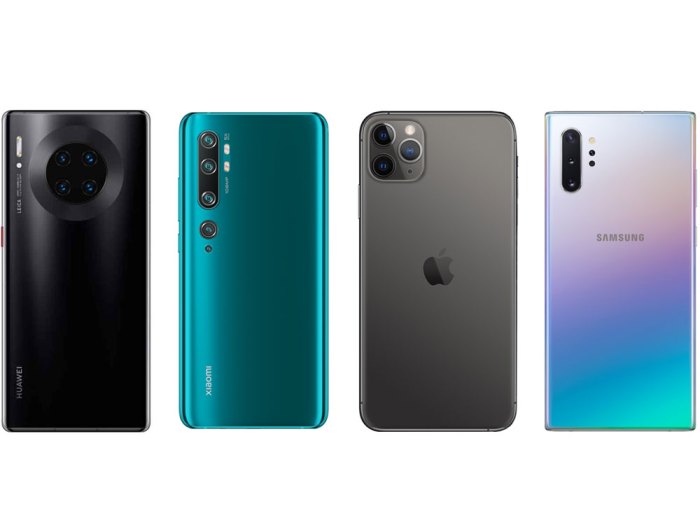Smartphone’s camera, once a simple novelty, has evolved into a powerful tool that captures our lives and the world around us. From the rudimentary cameras of early smartphones to the sophisticated multi-lens systems of today’s flagship models, this technological journey has been marked by significant advancements.
The rise of smartphone cameras has revolutionized photography and videography, making these activities accessible to everyone. The compact size and ease of use of smartphones have enabled people to capture moments spontaneously, share them instantly, and express their creativity in ways never before imagined.
Smartphone Camera Components
Smartphone cameras are a marvel of miniaturization, packing impressive technology into a small space. Understanding the key components that make up a smartphone camera system is essential for appreciating the quality of images and videos they produce.
Lens, Smartphone’s camera
The lens is the first element that light encounters in a smartphone camera. It’s responsible for focusing light onto the image sensor. Smartphone camera lenses are typically made of multiple glass elements arranged in a specific configuration to minimize distortion and aberrations.
Image Sensor
The image sensor is the heart of a smartphone camera. It’s a light-sensitive chip that converts incoming light into an electronic signal. The sensor is typically made of silicon and contains millions of tiny light-sensitive pixels, called photosites.
Image Processor
The image processor is responsible for processing the raw data captured by the image sensor. It performs various operations, including noise reduction, sharpening, color correction, and dynamic range adjustment, to produce a final image that is ready to be displayed or saved.
Autofocus System
The autofocus system ensures that the subject is in sharp focus. It uses various techniques, such as phase detection or contrast detection, to determine the optimal focus point and adjust the lens accordingly.
Other Components
- Flash: Provides additional light for low-light photography.
- Optical Image Stabilization (OIS): Helps to reduce camera shake, resulting in sharper images and videos.
- Zoom Lens: Allows for closer views of subjects without physically moving the camera.
How Components Work Together
These components work together seamlessly to capture high-quality images and videos. The lens focuses light onto the image sensor, which converts the light into an electronic signal. The image processor then processes this signal, enhancing it and producing a final image. The autofocus system ensures that the subject is in sharp focus, while the flash and OIS improve image quality in challenging lighting conditions.
Smartphone Camera Videography
Smartphone cameras have come a long way, and their video recording capabilities are no exception. Today’s smartphones can capture high-quality videos that rival professional cameras in many situations.
Video Recording Features
The quality of smartphone videos is determined by several factors, including resolution, frame rate, and stabilization.
- Resolution refers to the number of pixels in a video frame. Higher resolution videos have more pixels and provide greater detail and clarity. Most modern smartphones can record videos at resolutions ranging from 1080p (Full HD) to 4K. 4K videos offer four times the resolution of 1080p videos, resulting in incredibly sharp and detailed images.
- Frame rate determines how many frames are displayed per second. A higher frame rate results in smoother and more fluid motion, especially for fast-paced action or slow-motion footage. Most smartphones can record videos at 30 frames per second (fps), but some can record at higher frame rates like 60 fps or even 120 fps for slow-motion effects.
- Stabilization helps reduce camera shake and produce smoother videos, especially when shooting handheld. Optical image stabilization (OIS) is a more advanced form of stabilization that uses moving lens elements to compensate for camera movement, resulting in even smoother footage.
Tips for Shooting High-Quality Videos
Here are some tips for capturing high-quality videos with your smartphone:
- Clean the lens: Before shooting, ensure your lens is clean and free of smudges or fingerprints. A dirty lens can affect the clarity and sharpness of your videos.
- Use natural light: Natural light is usually the best lighting for videos. If shooting indoors, try to position yourself near a window or use a soft light source.
- Hold your phone steady: Use both hands to hold your phone steady while recording, or consider using a tripod or stabilizer to minimize camera shake.
- Use the grid: Many smartphone cameras have a grid overlay that can help you align your shots and create more balanced compositions.
- Experiment with different angles: Try shooting from different angles to add visual interest and variety to your videos.
- Focus on the audio: Good audio is just as important as good video. Use an external microphone or position your phone closer to the sound source for clearer audio.
- Edit your videos: After shooting, edit your videos to trim unwanted footage, add transitions, and enhance the overall quality.
Closing Notes: Smartphone’s Camera
As smartphone camera technology continues to evolve, we can expect even more innovative features and capabilities in the future. From advancements in computational photography and AI-powered image processing to the integration of augmented reality and other emerging technologies, the smartphone camera is poised to play an even more integral role in our lives. The journey of the smartphone camera is a testament to human ingenuity and the transformative power of technology, constantly pushing the boundaries of what’s possible in the world of imaging.
Smartphone cameras have become incredibly powerful, allowing us to capture stunning photos and videos with ease. This technological advancement is a testament to the incredible innovation happening in the world of smartphones. From high-resolution sensors to advanced image processing algorithms, smartphone cameras have truly revolutionized the way we document our lives.
 Informatif Berita Informatif Terbaru
Informatif Berita Informatif Terbaru
